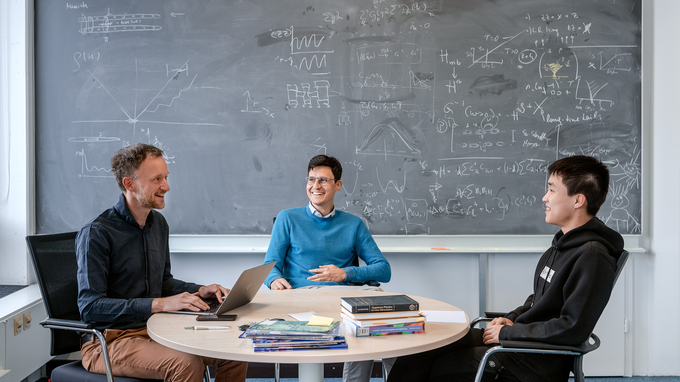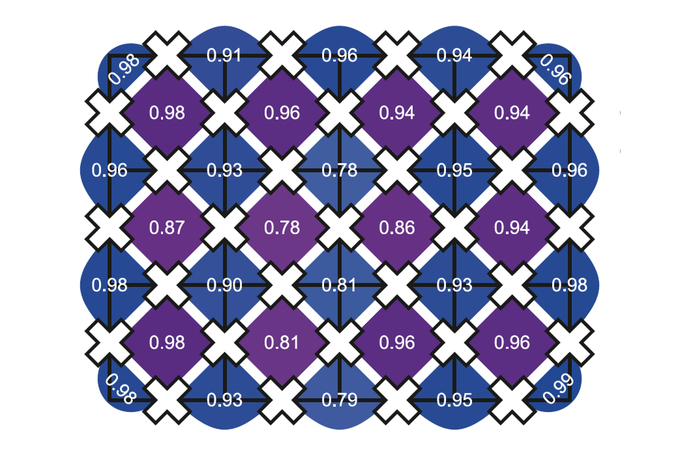Simulationen mit Quantencomputer
Quantenprozessor liefert Einblicke in exotische Zustände in Quantenmaterialien
2021-12-07 – Nachrichten aus dem Physik-Department

Wie wäre es, in einer flachen, zweidimensionalen Welt zu leben? Physiker sagen voraus, dass die Quantenmechanik in diesem Fall noch seltsamer wäre. Beispielsweise würde es exotische Teilchen geben, sogenannten „Anyons“, die es in unserer dreidimensionalen Welt nicht gibt. Doch diese unbekannte Welt ist nicht nur eine Kuriosität, sondern möglicherweise der Schlüssel zu Erschließung von Quantenmaterialien und -technologien der Zukunft.
In Zusammenarbeit mit dem Google Quantum AI Team haben Wissenschaftler der Technischen Universität München und der University of Nottingham einen gut kontrollierbaren Quantenprozessor eingesetzt, um solche Quantenmaterie-Zustände zu simulieren. In der aktuellen Ausgabe der renommierten Fachzeitschrift “Science” stellen sie ihre Ergebnisse vor.
Quantenteilchen in zweidimensionalen Systemen
Alle Partikel in unserer dreidimensionalen Welt sind entweder Bosonen oder Fermionen. Jedoch wurde bereits vor fast 50 Jahren theoretisch vorhergesagt, dass andere Arten von Teilchen, die sogenannten Anyons, existieren könnten, wenn Materie auf zwei Dimensionen beschränkt ist.
Solche zweidimensionalen Systeme sind die sogenannten topologischen Phasen der Materie, deren Entdeckung 2016 mit dem Nobelpreis gewürdigt wurde. Hier können Anyon-Teilchen als kollektive Anregungen entstehen.
„Das Verdrehen von Paaren dieser Anyons durch Umeinanderbewegen in der Simulation enthüllt ihre exotischen Eigenschaften – Physiker nennen das Flechtstatistiken“, sagt Dr. Adam Smith von der University of Nottingham.
Ein einfaches Bild für diese kollektiven Erregungen ist die „La Ola-Welle“ eines Stadionpublikums – sie hat eine genau definierte Position, aber sie kann ohne die Tausenden von Menschen nicht existieren, aus denen sich die Menge zusammensetzt. Die experimentelle Realisierung und Simulation solcher topologisch geordneter Zustände hat sich jedoch als äußerst schwierig erwiesen.
Quantenprozessoren als Plattform für kontrollierte Quantensimulationen
In wegweisenden Experimenten programmierten die Teams der TUM, der University of Nottingham und von Google Quantum AI den Quantenprozessor von Google, um diese zweidimensionalen Zustände der Quantenmaterie zu simulieren.
„Googles ‚Sycamore‘ Quantenprozessor kann präzise gesteuert werden und ist ein gut isoliertes Quantensystem, was eine wichtige Voraussetzung für die Durchführung von Quantenberechnungen ist“, sagt Erstautor Kevin Satzinger, ein Wissenschaftler aus dem Google-Team.
Mit dem von ihnen entwickelten Quantenalgorithmus konnte das Forschungsteam schließlich Zustände mit topologischer Ordnung realisieren, Anyon-Anregungen simulieren und gegeneinander verdrehen. Die Simulation zeigte auch die Auswirkungen weitreichender Quantenverschränkung. Eine mögliche Anwendung solcher topologisch geordneter Zustände sind neue Methoden der Fehlerkorrektur, um Quantencomputer zu verbessern. Erste Schritte in Richtung dieses Ziels wurden in der publizierten Arbeit bereits erreicht.
„Schon bald werden Quantenprozessoren eine ideale Plattform darstellen, um die Physik exotischer Phasen von Quantenmaterialien zu erforschen“, sagt Frank Pollmann, Professor für theoretische Festkörperphysik an der TUM. „In naher Zukunft versprechen Quantenprozessoren, Probleme zu lösen, die für die heutigen klassischen Supercomputer unerreichbar sind.“
- Redaktion
- Dr. Andreas Battenberg

Veröffentlichung
Weitere Informationen
Die Forschungsarbeiten wurden gefördert durch das European Research Council (ERC) im Rahmen des Forschungs- und Innovationsprogramms Horizon 2020 der Europäischen Union, die Deutsche Forschungsgemeinschaft (DFG) im Rahmen des Exzellenzclusters Munich Center for Quantum Science and Technology (MCQST) sowie des transregionalen Sonderforschungsbereichs TRR 80, durch die Max-Planck-Gesellschaft (MPG) über die International Max Planck Research School for Quantum Science and Technology (IMPRS-QST) und das Institute for Advanced Study der Technischen Universität München. Weitere Förderungen kamen von der Royal Commission for the Exhibition of 1851, dem Walter Burke Institute for Theoretical Physics at Caltech und dem IQIM, einem NSF Frontier Center, das von der Gordon und Betty Moore Foundation, der Packard Foundation und der Simons Foundation. Die beiden TUM-Autoren, Prof. Michael Knap und Prof. Frank Pollmann sind Mitglieder der Initiative Munich Quantum Valley und des Exzellenzclusters Munich Center for Quantum Science and Technology.
Verwandte Meldungen
- Prof. Dr. Rainer Blatt new TUM Distinguished Affiliated Professor – 2021-11-26
- Mit dem Munich Quantum Valley auf dem Weg in die Zukunft – 2021-01-08
- Hochdotierte EU-Förderung für Spitzenforschung – 2019-09-04
- Licht in der Nanowelt – 2019-08-01
- Was ist die perfekte Quantentheorie? – 2019-07-12
- Unsterbliche Quantenteilchen – 2019-06-27
Kontakt
- Technische Universität MünchenJames-Franck-Str. 1, 85748 Garching, GermanyTel.: +49 89 289 53760
- Dr. Pedram RoushanGoogle Quantum AI,Mountain View, CA, USATel.: +1 609 649 2317
- Dr. Adam SmithFaculty of ScienceSchool of Physics and AstronomyUniversity ParkNottingham, NG7 2RD, UK